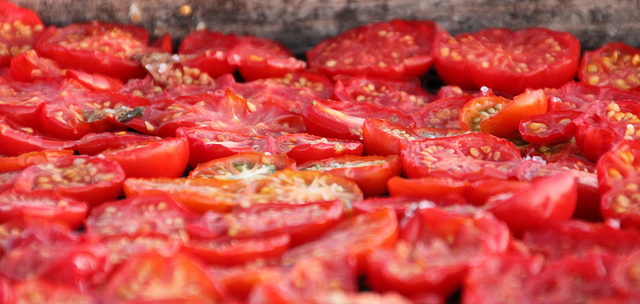How to Make Sun-dried Tomatoes
You probably already know that sun-dried tomatoes are high in antioxidants, namely Vitamin A & C, that lower the risk for heart disease, cancer, and diabetes; and that they contain Lycopene that has been proven to decrease the risk of heart attack. But did you know you can make them yourself for a fraction of the cost you'd pay in health food stores? That's right, you can make sun-dried tomatoes right in your own backyard
It's easy to do and you will soon have an inexpensive supply of delicious, sun-dried tomatoes for all your recipe needs. If you prefer not to fuss with drying them in the sun, you can get good results by either oven drying or the dehydrator method.
Preparation
Drying the Tomatoes
It's easy to do and you will soon have an inexpensive supply of delicious, sun-dried tomatoes for all your recipe needs. If you prefer not to fuss with drying them in the sun, you can get good results by either oven drying or the dehydrator method.
Preparation
- Choose the Right Tomatoes: Small meaty fruit make the best sun-dried tomatoes. Plum and Roma are ideal. Larger beefsteak varieties contain too much moisture to make good sun-dried tomatoes.
- Slice and Drain: Thoroughly wash and dry the tomatoes. Slice them into 1⁄2 inch slices and drain on paper towels to remove excess moisture.
Drying the Tomatoes
- Traditional Sun-Dried Tomatoes in the Sun: Although it may take up to 12 days, you can sun dry your own tomatoes by layering the slices on a screened tray and sitting them in the sun. Cover the tops with cheesecloth and prop the cloth up with a dowel (or clothespin) to keep the cheesecloth from resting on the tomatoes. Place the tray on a table or other wooden surface so that air can circulate under the tray. You can use small slats of wood or bricks to raise the tray. Move the tray inside at night to prevent condensation from settling on the tomatoes.
- Food Dehydrator Method for Sundried Tomatoes: If you have a food dehydrator, layer tomato slices to cover the racks. Depending on the number of racks you choose to use at once, they may take up to 12 hours to dry. Check them every few hours and move racks around if necessary.
- Oven Method for SunDried Tomatoes: If you have a gas stove, you are in luck. Layer the tomato slices on wire racks or foil lined baking sheets. The pilot light on the oven will provide enough heat to dry your tomatoes in 12 to 20 hours. If you have an electric oven, set the dial to warm. You may need to prop the door open slightly to prevent overheating.
How do you know when the tomatoes are dry enough?
Your tomatoes are ready when they are leathery. They should resemble the texture of a prune with some flexibility. Care must be taken not to remove them if they are still soft and squishy, and not to over-dry so they become brittle.
How do you store sun-dried tomatoes?
Once your sun-dried tomatoes are cooled; they can be stored in plastic storage bags for up to 6 months, or stored in the freezer for up to a year
How do you store sun-dried tomatoes in oil?
If desired, sun dried tomatoes can be stored in flavored olive oil. Simply re-hydrate the sun-dried tomatoes slightly until they are chewy, dip them in white vinegar, and cover them with olive oil with your choice of herbs and garlic. These must be refrigerated to preserve their flavor and color, and to prevent spoilage.
How do you rehydrate sun-dried tomatoes?
Simply soak dried tomatoes in warm water, sauce, or oil for 10 to 15 minutes until they are plump and soft.
Making your own sun-dried tomatoes will provide you with an inexpensive and easy supply of sun-dried tomatoes that you would have paid a small fortune for in health food or specialty stores. Use these tomatoes as you would any commercial sun-dried tomato.
